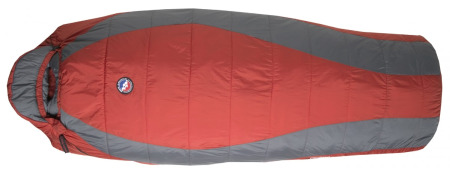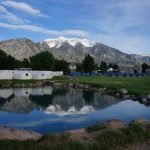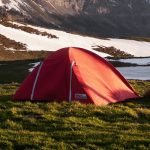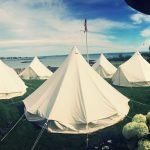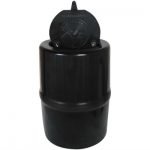To truly enjoy your outdoor adventures camping, hiking, and backpacking this Fall and Winter you need a good night’s rest! How can you get the best night of sleep away from your cozy bed at home? Prepare yourself with the best sleep plan you can!
How to set up your ideal sleep plan for camping in Fall and Winter:
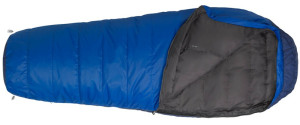 Tip 1: It’s all about the Bag! Your summer bag just won’t do. You must invest in, (Or Rent from Outdoors Geek!) a winter grade sleeping bag rated for at least – 10 degrees. A – 20 may not give you the versatility you want in warmer temps. But a zero temp rating may also not be enough protection in the worst of the winter months. Next, check the fit. Not every bag will fit you the same. You need to consider length. Get in, zip up, and try it out. Regular length sleeping bags work for those up to 5’11” or 6’0′. Your feet should not be touching insulation at the end of the bag. A little extra space is nice for slipping in your boot liners and socks to keep them warm through the night. Consider your needs, will you be in sub zero temps throughout the winter camping season? Will you need to invest in a down bag instead of a synthetic? How about a weather proof/water resistant outer shell? Or, if you’re not sure what you may need, consult the Geeks at Outdoors Geek. Ask your questions, and try your gear before you buy it.
Tip 1: It’s all about the Bag! Your summer bag just won’t do. You must invest in, (Or Rent from Outdoors Geek!) a winter grade sleeping bag rated for at least – 10 degrees. A – 20 may not give you the versatility you want in warmer temps. But a zero temp rating may also not be enough protection in the worst of the winter months. Next, check the fit. Not every bag will fit you the same. You need to consider length. Get in, zip up, and try it out. Regular length sleeping bags work for those up to 5’11” or 6’0′. Your feet should not be touching insulation at the end of the bag. A little extra space is nice for slipping in your boot liners and socks to keep them warm through the night. Consider your needs, will you be in sub zero temps throughout the winter camping season? Will you need to invest in a down bag instead of a synthetic? How about a weather proof/water resistant outer shell? Or, if you’re not sure what you may need, consult the Geeks at Outdoors Geek. Ask your questions, and try your gear before you buy it.
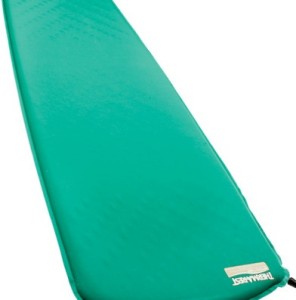 Tip 2: Protect your body from the ground! The Winter ground is one of the quickest ways to lose body heat at night. You need a good quality insulated sleeping pad to protect your body from the cold ground. The warmth of a pad can vary drastically depending on the thickness and the material of which the pad is made. Pay attention to the “R-value”. It is a measure assigned to the pad’s resistance to heat transfer. You want the pad to trap dead heat under you. The more dead air that remains trapped, the warmer it will keep you. If you plan to sleep in snowy conditions, you may want a 3.5 R-Value, which means the pad can insulate against snow covered grounds. Inflated pads and double stacking the pads are popular options for trapping heat. Your body heat should not be able to escape. The Pad is supposed to stop the transfer of heat to the cold ground. Check under your pad in the morning for ice. If you find melted snow, your pad didn’t do its job.
Tip 2: Protect your body from the ground! The Winter ground is one of the quickest ways to lose body heat at night. You need a good quality insulated sleeping pad to protect your body from the cold ground. The warmth of a pad can vary drastically depending on the thickness and the material of which the pad is made. Pay attention to the “R-value”. It is a measure assigned to the pad’s resistance to heat transfer. You want the pad to trap dead heat under you. The more dead air that remains trapped, the warmer it will keep you. If you plan to sleep in snowy conditions, you may want a 3.5 R-Value, which means the pad can insulate against snow covered grounds. Inflated pads and double stacking the pads are popular options for trapping heat. Your body heat should not be able to escape. The Pad is supposed to stop the transfer of heat to the cold ground. Check under your pad in the morning for ice. If you find melted snow, your pad didn’t do its job.
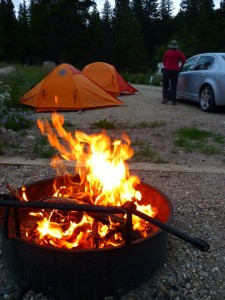 Tip 3: Add Heat! If you’re still looking to add extra heat, consider some of these options to turn up the heat in your bag!
Tip 3: Add Heat! If you’re still looking to add extra heat, consider some of these options to turn up the heat in your bag!
- Add an extra layer to separate more from the ground
- Don’t forget to add at least one layer to your head and neck
- Add a sleeping bag liner
- Add a hot water bottle or a hand warmer. Place it in the bag 30 minutes before you zip up for the night.
- Eat a high-calorie snack before bed to crank up your body’s internal burn.
Don’t be afraid of cold weather camping. With a few simple preparations you can enjoy the outdoors all season long! Camping season doesn’t end with Summer! Trust your geeks at Outdoors Geek for everything you need to make cold weather camping even more do-able!

